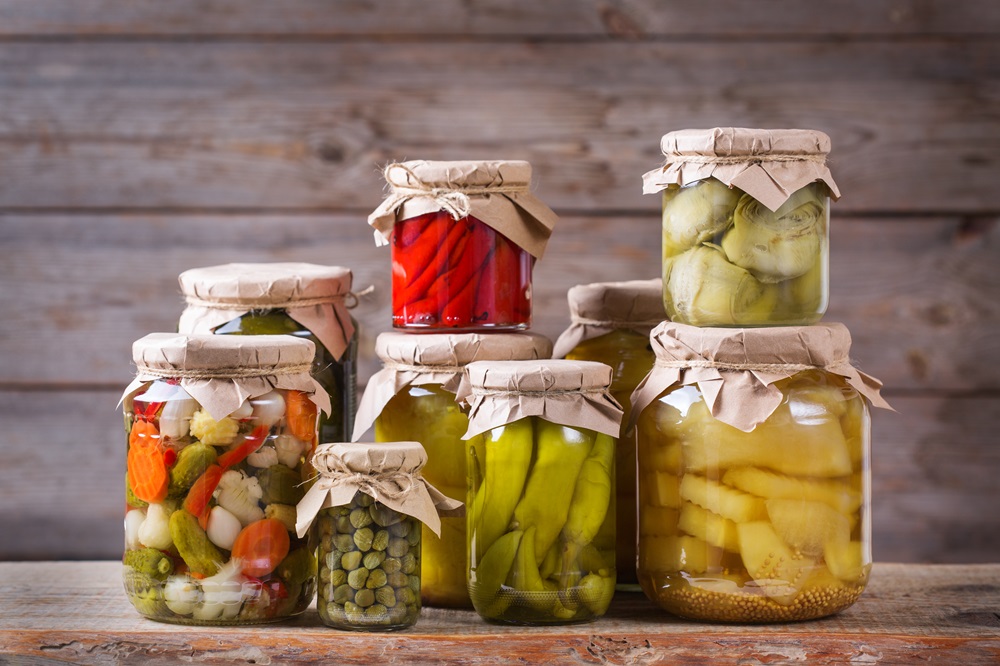Fermented Foods – What Are They and Are They Worth Eating?

Fermented foods are well known among fans of Polish cuisine, valued for their distinctive taste and aroma. They are created through lactic acid fermentation and can have a positive impact on the body, supporting the immune system and offering antioxidant potential. What exactly are fermented foods and what can be fermented? Is it worth including them in your diet? And how can you ferment vegetables and fruits at home?
Table of contents
- Fermented foods - what are they?
- What can be fermented?
- Fermented foods - nutritional value
- Fermented foods - health benefits. Are they good for you?
- Fermented foods - who should eat them?
- Fermentation rules - how to prepare fermented foods
- Fermented foods - recipes
- Pickled pears - recipe
- Pickled lemons - recipe
- Pickled foods - contraindications
Fermented foods - what are they?
Fermented foods are products preserved through fermentation, one of the oldest methods of food preservation. They are the result of a complex chemical process known as lactic acid fermentation, which relies on lactic acid bacteria.
During fermentation, simple sugars naturally present in foods are broken down into lactic acid. As a result, the pH of the product drops below 4.2, making it resistant to harmful microorganisms and spoilage bacteria. At the same time, bacteriocins are produced, which further stabilize the food, allowing fermented products to be stored and safely consumed even after many months.
Fermented foods stand out for their unique sensory qualities. Their characteristic flavor and aroma are the effect of both homofermentative and heterofermentative lactic acid bacteria working together.
What can be fermented?
Vegetables are most commonly used for fermentation, but fruits are becoming increasingly popular as well. Examples of fermented foods include:
- pickles
- sauerkraut
- fermented zucchini
- fermented carrots
- fermented peppers
- fermented beets
- fermented pumpkin
- fermented celery
- fermented lemons
- fermented tomatoes
- fermented radishes
- fermented grapes
- fermented pears
- fermented cherries
Fermented products like kimchi are also gaining popularity. This traditional Korean dish of spicy fermented vegetables is usually made with napa cabbage, though radish, cucumber, or scallions can also be used.
When choosing foods for fermentation, it’s important to remember that lactic acid fermentation softens the texture. That’s why firm, ripe, and fresh vegetables and fruits work best. The taste and aroma of fermented foods can also be enhanced by spices such as dill, allspice, garlic, caraway, or parsley.
Fermented foods - nutritional value
Fermented foods are appreciated mainly for their taste, but they offer far more than just a unique flavor and aroma. They are also a source of valuable nutrients and are considered natural probiotics. In fermented foods you can find compounds such as:
- vitamin A
- vitamin C
- vitamin E
- B vitamins including thiamine, riboflavin, and niacin
- lactic acid bacteria
- calcium
- potassium
- iron
- magnesium
- phosphorus
- dietary fiber
- acetylcholine
Fermented foods - health benefits. Are they good for you?
Thanks to their rich nutrient profile, fermented foods may have a positive effect on the human body. The presence of lactic acid bacteria, often referred to as probiotics, means they can support digestion, benefit gut microbiota, strengthen immune cells, and improve nutrient absorption, while also showing antibacterial properties. Probiotics found in fermented foods may additionally support the urinary and reproductive systems, helping to lower the risk of infections.
Fermented vegetables and fruits are also a source of vitamins A, E, and C, which act as antioxidants. They help fight free radicals and reactive oxygen species, reduce oxidative stress, and slow down aging processes. Vitamin A supports healthy vision and skin, vitamin E strengthens the epidermis, has anti-inflammatory effects, and may benefit fertility, while vitamin C boosts the immune system, supports collagen production, contributes to nervous system function, and helps reduce fatigue.
Fermented foods also contain B vitamins with diverse benefits. Riboflavin (B2) supports healthy red blood cells, thiamine (B1) contributes to proper heart function, and niacin (B3), also called vitamin PP, supports healthy mucous membranes and psychological well-being.
On top of that, fermented products are rich in minerals that help regulate fluid and electrolyte balance, support nervous system function, play a role in DNA synthesis and red blood cell production, and contribute to maintaining healthy blood pressure.
They are also a source of dietary fiber, which aids digestion, regulates bowel movements, promotes satiety, and helps maintain healthy cholesterol levels. Acetylcholine present in fermented foods may support heart function and nerve impulse transmission.
Interestingly, the naturally low pH of fermented foods improves nutrient bioavailability, which may reduce the risk of deficiencies and support overall health.
Fermented foods - who should eat them?
Fermented products are a valuable part of a balanced diet. They are especially recommended for people with digestive issues and for those following weight-loss diets. Fermented foods are low in calories yet high in fiber, which increases satiety and makes them a helpful addition to a weight management plan.
Fermentation rules - how to prepare fermented foods
Making fermented foods is simple and doesn’t require special skills. However, for the process to succeed, it’s important to remember that:
- the food used must contain natural sugars - usually high-carbohydrate vegetables or fruits,
- lactic acid bacteria are necessary for fermentation,
- only fresh produce should be used,
- fermentation should take place at room temperature, below 20°C (68°F),
- the process requires relatively anaerobic conditions,
- produce must be washed thoroughly beforehand,
- the ideal moisture content is between 50-70%,
- spices such as allspice, dill, bay leaves, garlic, or caraway can enhance the flavor,
- jars should be sterilized before use,
- vegetables and fruits should be completely submerged in brine, as partial coverage may lead to mold growth and spoilage.
Fermented foods - recipes
In Polish tradition, cucumbers and cabbage are the most common fermented products. However, more and more everyday ingredients are being used as well. For example, fermented radishes can be a delicious and refreshing option.
Fermented radishes - recipe
| Składniki | Sposób przygotowania |
|---|---|
|
0.5 kg radishes, brine: 1 tablespoon of table salt per 1 liter of water, allspice, bay leaf, horseradish. |
Wash the radishes, remove the ends, slice them, and place them in a large jar. Add allspice, bay leaf, horseradish, and the prepared brine to the jar. Close the jar and leave it at room temperature to ferment. |
Fruit is also increasingly being used for pickling, and one of the delicious ingredients that tastes great after pickling is the pear. How to prepare pickled pears?
Pickled pears - recipe
| Składniki | Sposób przygotowania |
|---|---|
|
1 kg of firm pears, 1 liter of water, 1 tablespoon of table salt, cardamom, cinnamon, cloves. |
Wash and peel the pears, then remove the cores. Cut the fruit into quarters and place in a jar. Add cinnamon, cloves, and cardamom, then pour in brine made from water and salt. Seal the jar tightly and leave at room temperature to ferment. |
Pickled lemons are also becoming increasingly popular among consumers, as they can be used as an original addition to many dishes. This specialty originates from Moroccan cuisine and delights with its taste and aroma. How to pickle lemons?
Pickled lemons - recipe
| Składniki | Sposób przygotowania |
|---|---|
|
8 lemons, 6 tablespoons coarse salt, cinnamon, bay leaf, cloves, rosemary, ginger, water. |
Wash and dry the lemons. Cut four lemons in such a way that the bottom remains intact, and place salt in the cuts. Put the lemons in a jar and add the remaining spices - cinnamon, bay leaf, cloves, rosemary, and ginger. Squeeze the juice from the remaining four lemons and pour it over the fruit in the jar. If the lemon juice does not cover the fruit in the jar, add water until the lemons are completely covered. Close the jar tightly and leave it at room temperature to ferment. |
Pickled foods - contraindications
Pickled foods are products distinguished by their richness in valuable compounds that can have a beneficial effect on the human body. However, pickled products are not always recommended. People struggling with hypertension should exercise caution when including pickled foods in their daily diet, as pickled vegetables and fruits may contain significant amounts of salt.
In addition, consumers struggling with histamine intolerance, which may be present in fermented foods, should avoid pickled foods.
Excessive amounts of pickled foods can also have a negative effect on the bodies of people taking anticoagulants, as well as on consumers with sensitive digestive systems.

